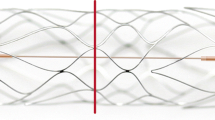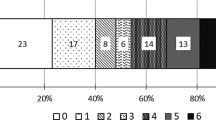Abstract
Purpose
Stent retrievers apply mechanical force to the intracranial vasculature. Our aim was to evaluate the safety and efficacy of the long Solitaire 4 × 40 mm stent retriever for large vessel occlusion in stroke patients.
Methods
We conducted a retrospective analysis of all patients treated for acute ischemic large vessel occlusion stroke with the Solitaire 2 FR 4 × 40 device between May and October 2016 at our institution. Patient-specific data at baseline and at discharge were documented. Reperfusion was graded with the thrombolysis in cerebral infarction (TICI) classification. Postinterventional angiograms and follow-up cross-sectional imaging were used to evaluate complications.
Results
TICI 2b/3 recanalization was achieved in 20 of 23 patients (87.0%), in 17 patients with the first retriever pass. NIHSS improved from a mean score at presentation of 16 (range 4–36) to 11 (range 0–41) at discharge. Mean mRS score at discharge was 3 (range 0–6) and 3 (range 0–6) at 90 days post-treatment. No infarcts in other territories were observed. One patient showed a (reversible) vasospasm in the postinterventional angiogram and another a small contrast extravasation in follow-up imaging.
Conclusion
The Solitaire 2 FR 4 × 40 stent retriever is a safe and efficient device for large vessel occlusion acute ischemic stroke with a high recanalization rate and a low peri- and postinterventional complication rate together with a good clinical outcome. Despite potentially higher friction and shearing forces, no increased incidence of visible damage to the vessel wall was observed.


Similar content being viewed by others
References
Kidwell CS, Jahan R, Gornbein J, Alger JR, Nenov V, Ajani Z, et al. A trial of imaging selection and endovascular treatment for ischemic stroke. N Engl J Med. 2013;368:914–23.
Berkhemer OA. A randomized trial of intraarterial treatment for acute ischemic stroke. N Engl J Med. 2015;318:1565.
Saver JL, Goyal M, Bonafe A, Diener H-C, Levy EI, Pereira VM, et al. Stent-retriever thrombectomy after intravenous t-PA vs. t-PA alone in stroke. N Engl J Med. 2015;372:2285–95.
Goyal M, Menon BK, van Zwam WH, Dippel DW, Mitchell PJ, Demchuk AM, et al. Endovascular thrombectomy after large-vessel ischaemic stroke: a meta-analysis of individual patient data from five randomised trials. Lancet. 2016;387:1723–31.
Akins PT, Amar AP, Pakbaz RS, Fields JD. Complications of endovascular treatment for acute stroke in the SWIFT trial with Solitaire and Merci devices. Am J Neuroradiol. 2014;35:524–8.
Campbell BCV, Mitchell PJ, Kleinig TJ, Dewey HM, Churilov L, Yassi N, et al. Endovascular therapy for ischemic stroke with perfusion-imaging selection. N Engl J Med. 2015;372:1009–18.
Kühn AL, Wakhloo AK, Lozano JD, Massari F, De Macedo Rodrigues K, Marosfoi MG, et al. Two-year single-center experience with the “Baby Trevo” stent retriever for mechanical thrombectomy in acute ischemic stroke. J Neurointerv Surg. 2016; neurintsurg-2016-012454.
Riedel CH, Zimmermann P, Jensen-Kondering U, Stingele R, Deuschl G, Jansen O. The importance of size: successful recanalization by intravenous thrombolysis in acute anterior stroke depends on thrombus length. Stroke. 2011;42:1775–7.
Mordasini P, Brekenfeld C, Byrne JV, Fischer U, Arnold M, Heldner MR, et al. Technical feasibility and application of mechanical thrombectomy with the Solitaire FR revascularization device in acute basilar artery occlusion. Am J Neuroradiol. 2013;34:159–63.
Thierfelder KM, Sommer WH, Ertl-Wagner B, Beyer SE, Meinel FG, Kunz WG, et al. Prediction of stent-retriever thrombectomy outcomes by dynamic multidetector ct angiography in patients with acute carotid t or mca occlusions. Am J Neuroradiol. 2016;37:1296–302.
Wainwright JM, Jahan R. Solitaire FR revascularization device 4 × 40: safety study and effectiveness in preclinical models. J Neurointerv Surg. 2016;8:710–3.
Zaidat OO, Yoo AJ, Khatri P, et al. Recommendations on angiographic revascularization grading standards for acute ischemic stroke. Stroke. 2013;44:2650–63.
Larrue V, von Kummer RR, Müller ABE. Risk factors for severe hemorrhagic transformation in ischemic stroke patients treated with recombinant tissue plasminogen activator: a secondary analysis of the European-Australasian Acute Stroke Study (ECASS II). Stroke. 2001;32:438–41.
Machi P, Jourdan F, Ambard D, Reynaud C, Lobotesis K, Sanchez M, et al. Experimental evaluation of stent retrievers’ mechanical properties and effectiveness. J Neurointerv Surg. 2017;9(3):257–63.
Abraham P, Cheung VJ, Lee R, Pannell JS, Gupta M, Rennert R, et al. 302 Vessel wall enhancement on magnetic resonance imaging after stent-retriever thrombectomy. Neurosurgery. 2016;63(Suppl 1):186.
Li Y, Turan TN, Chaudry I, Spiotta AM, Turk AS, Turner RD, et al. High-resolution magnetic resonance imaging evidence for intracranial vessel wall inflammation following endovascular thrombectomy. J Stroke Cerebrovasc Dis. 2017;26:e96–8.
Hsieh K, Verma RK, Schroth G, Gratz PP, Kellner-Weldon F, Gralla J, et al. Multimodal 3 Tesla MRI confirms intact arterial wall in acute stroke patients after stent-retriever thrombectomy. Stroke. 2014;45:3430–2.
Author information
Authors and Affiliations
Corresponding author
Ethics declarations
Conflict of interest
Jan Gralla: Global PI of STAR Study and Global PI of the SWIFT Direct trial, Consultant for Medtronic.
Ethical Approval Statement
For this type of study, formal consent is not required.
Informed Consent Statement
Informed consent was obtained from all individual participants included in the study.
Rights and permissions
About this article
Cite this article
Zibold, F., Mordasini, P., Mosimann, P. et al. Safety of the Solitaire 4 × 40 mm Stent Retriever in the Treatment of Ischemic Stroke. Cardiovasc Intervent Radiol 41, 49–54 (2018). https://doi.org/10.1007/s00270-017-1785-z
Received:
Accepted:
Published:
Issue Date:
DOI: https://doi.org/10.1007/s00270-017-1785-z




